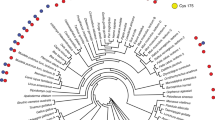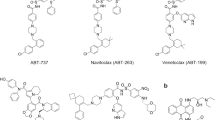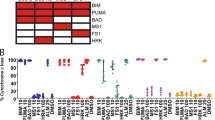Abstract
The Bcl-2-related survival proteins confer cellular resistance to a wide range of agents. Bcl-xL-expressing hepatocyte cell lines are resistant to tumour necrosis factor and anti-cancer drugs, but are more sensitive than isogenic control cells to antimycin A, an inhibitor of mitochondrial electron transfer. Computational molecular docking analysis predicted that antimycin A interacts with the Bcl-2 homology domain 3 (BH3)-binding hydrophobic groove of Bcl-xL. We demonstrate that antimycin A and a Bak BH3 peptide bind competitively to recombinant Bcl-2. Antimycin A and BH3 peptide both induce mitochondrial swelling and loss of ΔΨm on addition to mitochondria expressing Bcl-xL. The 2-methoxy derivative of antimycin A3 is inactive as an inhibitor of cellular respiration but still retains toxicity for Bcl-xL+ cells and mitochondria. Finally, antimycin A inhibits the pore-forming activity of Bcl-xL in synthetic liposomes, demonstrating that a small non-peptide ligand can directly inhibit the function of Bcl-2-related proteins.
This is a preview of subscription content, access via your institution
Access options
Subscribe to this journal
Receive 12 print issues and online access
$209.00 per year
only $17.42 per issue
Buy this article
- Purchase on Springer Link
- Instant access to full article PDF
Prices may be subject to local taxes which are calculated during checkout







Similar content being viewed by others
References
Kelekar, A. & Thompson, C. B. Bcl-2-family proteins: the role of the BH3 domain in apoptosis. Trends Cell Biol. 8 , 324–330 (1998).
Chittenden, T. et al. A conserved domain in Bak, distinct from BH1 and BH2, mediates cell death and protein binding functions. EMBO J. 14 , 5589–5596 (1995).
Sattler, M. et al. Structure of Bcl-xL–Bak peptide complex: recognition between regulators of apoptosis. Science 275, 983–986 (1997).
Holinger, E. P., Chittenden, T. & Lutz, R. J. Bak BH3 peptides antagonize Bcl-xL function and induce apoptosis through cytochrome c-independent activation of caspases. J. Biol. Chem. 274, 13298–13304 (1999).
Cosulich, S. C., Worrall, V., Hedge, P. J., Green, S. & Clarke, P. R. Regulation of apoptosis by BH3 domains in a cell-free system. Curr. Biol. 7, 913–920 (1997).
Kroemer, G., Zamzami, N. & Susin, S. A. Mitochondrial control of apoptosis. Immunol. Today 18, 44–51 ( 1997).
Green, D. R. & Reed, J. C. Mitochondria and apoptosis. Science 281, 1309–1312 ( 1998).
Zamzami, N. et al. Reduction in mitochondrial potential constitutes an early irreversible step of programmed lymphocyte death in vivo. J. Exp. Med. 181, 1661–1672 (1995).
Zamzami, N. et al. Mitochondrial control of nuclear apoptosis. J. Exp. Med. 183, 1533–1544 (1996).
Kluck, R. M., Bossy-Wetzel, E., Green, D. R. & Newmeyer, D. D. The release of cytochrome c from mitochondria: a primary site for Bcl-2 regulation of apoptosis. Science 275, 1132 –1136 (1997).
Susin, S. A. et al. Molecular characterization of mitochondrial apoptosis-inducing factor. Nature 397, 441– 446 (1999).
Fisher, D. E. Apoptosis in cancer therapy: crossing the threshold. Cell 78, 539–542 (1994).
Minn, A. J., Rudin, C. M., Boise, L. H. & Thompson, C. B. Expression of Bcl-xL can confer a multidrug resistance phenotype. Blood 86, 1903–1910 ( 1995).
Decaudin, D. et al. Bcl-2 and Bcl-XL antagonize the mitochondrial dysfunction preceding nuclear apoptosis induced by chemotherapeutic agents. Cancer Res. 57, 62–67 ( 1997).
Slater, E. C. & Colpa-Boonstra, J. P. in Haematin Enzymes (eds Falk, J. E., Lemberg, R. and Morton, R. K.) 575– 592 (Pergamon, Oxford, 1961).
Salvioli, S., Ardizzoni, A., Franceschi, C. & Cossarizza, A. JC-1, but not DiOC6(3) or rhodamine 123, is a reliable fluorescent probe to assess ΔΨ changes in intact cells: implications for studies on mitochondrial functionality during apoptosis. FEBS Lett. 411, 77–82 (1997).
Cossarizza, A., Baccarani-Contri, M., Kalashnikova, G. & Franceschi, C. A new method for the cytofluorimetric analysis of mitochondrial membrane potential using the J-aggregate forming lipophilic cation 5,5′,6,6′-tetrachloro-1,1′,3,3′-tetraethylbenzimidazolcarbocyanine iodide (JC-1). Biochem. Biophys. Res. Commun. 197, 40–45 (1993).
Smiley, S. T. et al. Intracellular heterogeneity in mitochondrial membrane potentials revealed by a J-aggregate-forming lipophilic cation JC-1. Proc. Natl Acad. Sci. USA 88, 3671–3675 (1991).
Mancini, M. et al. Mitochondrial proliferation and paradoxical membrane depolarization during terminal differentiation and apoptosis in a human colon carcinoma cell line. J. Cell Biol. 138, 449– 469 (1997).
Xiang, J., Chao, D. T. & Korsmeyer, S. J. BAX-induced cell death may not require interleukin-1-converting enzyme-like proteases. Proc. Natl Acad. Sci. USA 93 , 14559–14563 (1996).
Zoratti, M. & Szabo, I. The mitochondrial permeability transition . Biochim. Biophys. Acta 1241, 139– 176 (1995).
Fonyo, A., Lukacs, G. & Ligeti, E. Participation of inorganic phosphate in the chemiosmotic mechanism of mitochondrial energy transduction. Acta Biol. Med. Ger. 40, 907–914 ( 1981).
Kuntz, I. D. Structure-based strategies for drug design and discovery. Science 257, 1078–1082 ( 1992).
Berden J. A. & Slater, E. C. The allosteric binding of antimycin to cytochrome b in the mitochondrial membrane. Biochim. Biophys. Acta 256, 199–215 (1972).
vander Heiden, M. G., Chandel, N. S., Williamson, E. K., Schumacker, P. T. & Thompson, C. B. Bcl-xL regulates the membrane potential and volume homeostasis of mitochondria. Cell 91, 627–637 ( 1997).
Miyoshi, H. et al. A model of antimycin A binding based on structure-activity studies of synthetic antimycin A analogues. Biochim. Biophys. Acta 1229, 149–154 ( 1995).
Tokutake, N., Miyoshi, H., Satoh, T., Hatano, T. & Iwamura, H. Structural factors of antimycin A molecule required for inhibitory action. Biochim. Biophys. Acta 1185, 271–278 (1994).
Dunshee, B. R., Leben, C., Keitt, G. W. & Strong, F. M. The isolation and properties of antimycin A. J. Am. Chem. Soc. 71 , 2436–2437 (1949).
Xia, D. et al. Crystal structure of the cytochrome bc1 complex from bovine heart mitochondria. Science 277, 60–66 (1997).
Hennet, T., Bertoni, G., Richter, C. & Peterhans, E. Expression of BCL-2 protein enhances the survival of mouse fibrosarcoid cells in tumor necrosis factor-mediated cytotoxicity. Cancer Res. 53, 1456–1460 (1993).
Narita, M. et al. Bax interacts with the permeability transition pore to induce permeability transition and cytochrome c release in isolated mitochondria . Proc. Natl Acad. Sci. USA 95, 14681– 14686 (1998).
McDonnell, J. M., Fushman, D., Milliman, C.L, Korsmeyer, S. J. & Cowburn, D. Solution structure of the proapoptotic molecule BID: a structural basis for apoptotic agonists and antagonists. Cell 96, 625–634 ( 1999).
Minn, A. J. et al. Bcl-x(L) forms an ion channel in synthetic lipid membranes . Nature 385, 353–357 (1997).
vander Heiden, M. G. et al. Bcl-xL prevents cell death following growth factor withdrawal by facilitating mitochondrial ATP/ADP exchange. Mol. Cell 3, 159–167 (1999).
Shimizu, S., Narita, M. & Tsujimoto, Y. Bcl-2 family proteins regulate the release of apoptogenic cytochrome c by the mitochondrial channel VDAC. Nature 399, 483–487 (1999).
Zamzami, N. et al. The thiol crosslinking agent diamide overcomes the apoptosis-inhibitory effect of Bcl-2 by enforcing mitochondrial permeability transition. Oncogene 16, 1055–1063 ( 1998).
Cheng, E. H. et al. Conversion of Bcl-2 to a Bax-like death effector by caspases . Science 278, 1966–1968 (1997).
Clem, R. J. et al. Modulation of cell death by Bcl-XL through caspase interaction . Proc. Natl Acad. Sci. USA 95, 554– 559 (1998).
Lewis, J. et al. Inhibition of virus-induced neuronal apoptosis by Bax. Nature Med. 5, 832–835 ( 1999).
Middleton, G., Nunez, G. & Davies, A. M. Bax promotes neuronal survival and antagonises the survival effects of neurotrophic factors. Development 122, 695–701 (1996).
Kiefer, M. C. et al. Modulation of apoptosis by the widely distributed Bcl-2 homologue Bak. Nature 374, 736–739 (1995).
Campo, M. L., Kinnally, K. W. & Tedeschi, H. The effect of antimycin A on mouse liver inner mitochondrial membrane channel activity. J. Biol. Chem. 267, 8123–8127 (1992).
Wu, J. C., Merlino, G., Cveklova, K., Mosinger, B. Jr., & Fausto, N. Autonomous growth in serum-free medium and production of hepatocellular carcinomas by differentiated hepatocyte lines that overexpress transforming growth factor alpha 1. Cancer Res. 54, 5964–5973 (1994).
Wu, J. C., Merlino, G. & Fausto, N. Establishment and characterization of differentiated, nontransformed hepatocyte cell lines derived from mice transgenic for transforming growth factor alpha. Proc. Natl Acad. Sci. USA 91, 674–678 (1994).
Hockenbery, D., Nunez, G., Milliman, C., Schreiber, R. D. & Korsmeyer, S. J. Bcl-2 is an inner mitochondrial membrane protein that blocks programmed cell death. Nature 348, 334–336 (1990).
Mayer, L. D., Hope, M. J. & Cullis, P. R. Vesicles of variable sizes produced by a rapid extrusion procedure. Biochim. Biophys. Acta 858, 161 –168 (1986).
Stewart, P. R. Colorimetric determination of phospholipids with ammonium ferrothiocyanate . Anal. Biochem. 104, 10– 14 (1980).
van Tamelen, E. E., Dickie, J. P., Loomans, M. E., Dewey, R. S. & Strong, F. M. The chemistry of antimycin A X: structure of the antimycins. J. Am. Chem. Soc. 83, 1639–1646 (1961).
Acknowledgements
We thank N. Fausto for providing TAMH, AML-12 and NMH cell lines; C. Thompson for providing FL5.12-Bcl-xL and FL5.12-neo cell lines; J. Foote and J. O'Neill for help and discussions; and R. Wiseman for assistance with oximetry measurements. This work was supported by NIH grant CA15704-26 (D.M.H.) and by an American Cancer Society grant RPG-97-173-01-LBC (K.Y.J.Z.). S.T. is an American Gastroenterological Association Research Scholar and a recipient of the Daland Fellowship for Research in Clinical Medicine from American Philosophical Society.
Author information
Authors and Affiliations
Corresponding author
Rights and permissions
About this article
Cite this article
Tzung, SP., Kim, K., Basañez, G. et al. Antimycin A mimics a cell-death-inducing Bcl-2 homology domain 3. Nat Cell Biol 3, 183–191 (2001). https://doi.org/10.1038/35055095
Received:
Revised:
Accepted:
Published:
Issue Date:
DOI: https://doi.org/10.1038/35055095
This article is cited by
-
Fluorescence lifetime imaging and electron microscopy: a correlative approach
Histochemistry and Cell Biology (2022)
-
BH3-mimetics: recent developments in cancer therapy
Journal of Experimental & Clinical Cancer Research (2021)
-
The therapeutic potential of mitochondrial toxins
The Journal of Antibiotics (2021)
-
A synthetic ion transporter that disrupts autophagy and induces apoptosis by perturbing cellular chloride concentrations
Nature Chemistry (2017)
-
Differences in clinical importance of Bcl-2 in breast cancer according to hormone receptors status or adjuvant endocrine therapy
BMC Cancer (2015)



